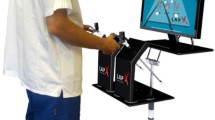Abstract
Advanced medical simulators have been introduced to facilitate surgical and endoscopic training and thereby improve patient safety. Residents trained in the Procedicus Minimally Invasive Surgical Trainer-Virtual Reality (MIST-VR) laparoscopic simulator perform laparoscopic cholecystectomy safer and faster than a control group. Little has been reported regarding whether factors like gender, computer experience, and visuospatial tests can predict the performance with a medical simulator. Our aim was to investigate whether such factors influence the performance of simulated gastroscopy. Seventeen medical students were asked about computer gaming experiences. Before virtual endoscopy, they performed the visuospatial test PicCOr, which discriminates the ability of the tested person to create a three-dimensional image from a two-dimensional presentation. Each student performed one gastroscopy (level 1, case 1) in the GI Mentor II, Simbionix, and several variables related to performance were registered. Percentage of time spent with a clear view in the endoscope correlated well with the performance on the PicSOr test (r = 0.56, P < 0.001). Efficiency of screening also correlated with PicSOr (r = 0.23, P < 0.05). In students with computer gaming experience, the efficiency of screening increased (33.6% +- 3.1% versus 22.6% +- 2.8%, P < 0.05) and the duration of the examination decreased by 1.5 minutes (P < 0.05). A similar trend was seen in men compared with women. The visuospatial test PicSOr predicts the results with the endoscopic simulator GI Mentor II. Two-dimensional image experience, as in computer games, also seems to affect the outcome.
Similar content being viewed by others
References
Albert JG, Riemann JF. ERCP and MRCP—When and why. Best Pract Res Clin Gastroenterol 2002;16:399–419.
Enochsson L, Lindberg B, Swahn F, Arnelo U. Intraoperative endoscopic retrograde cholangiopancreatography (ERCP) to remove common bile duct stones during routine laparoscopic cholecystectomy does not prolong hospitalization: A 2-year experience. Surg Endosc 2004;18:367–371.
Ferlitsch A, Glauninger P, Gupper A, et al. Evaluation of a virtual endoscopy simulator for training in gastrointestinal endoscopy. Endoscopy 2002;34:698–702.
Ritter EM, McClusky DA 3rd, Lederman AB, Gallagher AG, Smith CD. Objective psychomotor skills assessment of experienced and novice flexible endoscopists with a virtual reality simulator. J GASTROINTEST SURG 2003;7:871–877; discussion 877–878.
Seymour NE, Gallagher AG, Roman SA, et al. Virtual reality training improves operating room performance: Results of a randomized, double-blinded study. Ann Surg 2002;236:458–463; discussion 463-454.
Sedlack RE, Kolars JC. Computer simulator training enhances the competency of gastroenterology fellows at colonoscopy: Results of a pilot study. Am J Gastroenterol 2004; 99:33–37.
Csikszentmihalyi M. Happiness, flow, and economic equality. Am Psychol 2000;55:1163–1164.
Csikszentmihalyi M, LeFevre J. Optimal experience in work and leisure. J Pers Soc Psychol 1989;56:815–822.
Csikszentmihalyi M, Rathunde K. The measurement of flow in everyday life: Toward a theory of emergent motivation. Nebr Symp Motiv 1992;40:57–97.
Gallagher AG, Cowie R, Crothers I, Jordan-Black JA, Satava RM. PicSOr: An objective test of perceptual skill that predicts laparoscopic technical skill in three initial studies of laparoscopopic performance. Surg Endosc 2003;17:1468–1471.
Ghani JA, Deshpande SP. Task characteristics and the experience of optimal flow in human-computer interaction. J Psychol 1994;128:381–391.
Grantcharov TP, Bardram L, Funch-Jensen P, Rosenberg J. Impact of hand dominance, gender, and experience with computer games on performance in virtual reality laparoscopy. Surg Endosc 2003; May 6 (Epub).
Kiesslich R, von Bergh M, Hahn M, Hermann G, Jung M. Chromoendoscopy with indigocarmine improves the detection of adenomatous and nonadenomatous lesions in the colon. Endoscopy 2001;33:1001–1006.
Strom P, Kjellin A, Hedman L, et al. Validation and learning in the Procedicus KSA virtual reality surgical simulator. Surg Endosc 2003;17:227–231.
Author information
Authors and Affiliations
Corresponding author
Rights and permissions
About this article
Cite this article
Enochsson, L., Isaksson, B., Tour, R. et al. Visuospatial skills and computer game experience influence the performance of virtual endoscopy. J Gastrointest Surg 8, 874–880 (2004). https://doi.org/10.1016/j.gassur.2004.06.015
Issue Date:
DOI: https://doi.org/10.1016/j.gassur.2004.06.015




